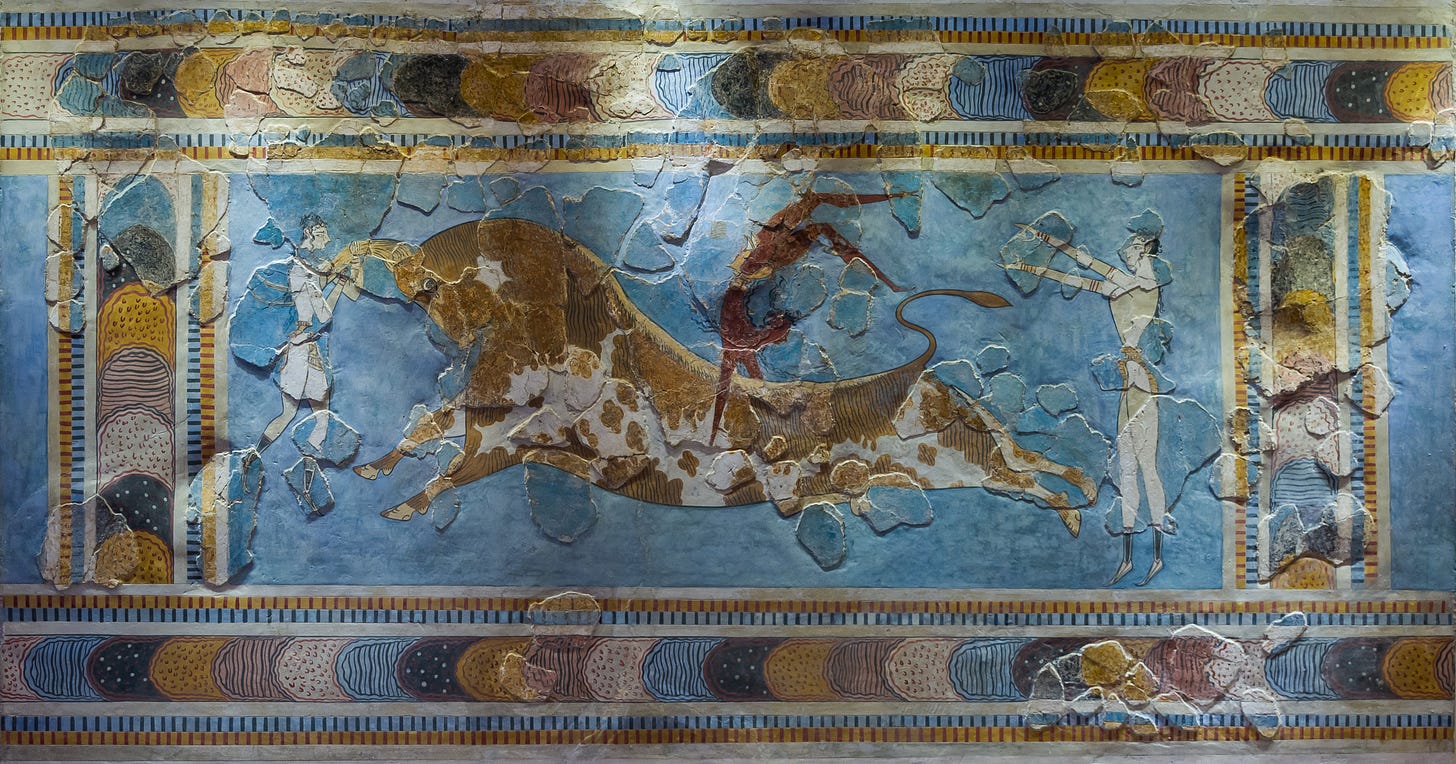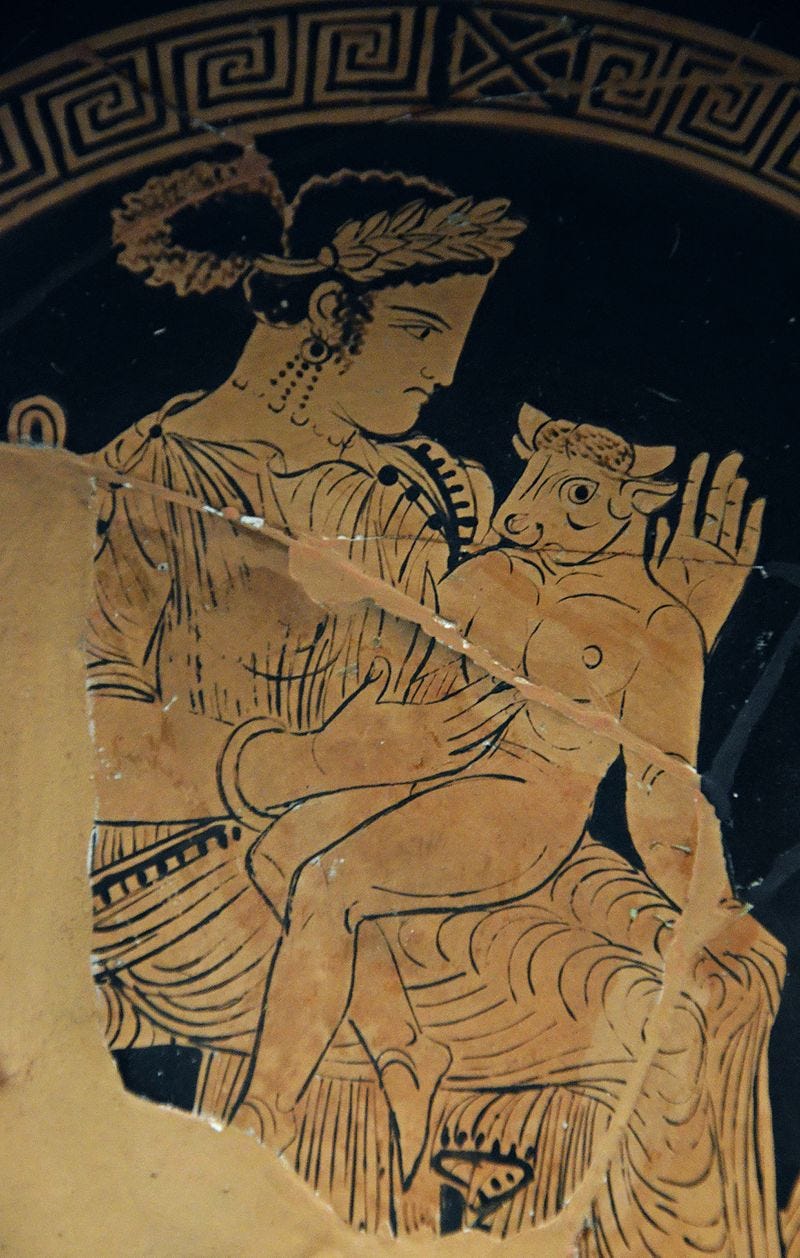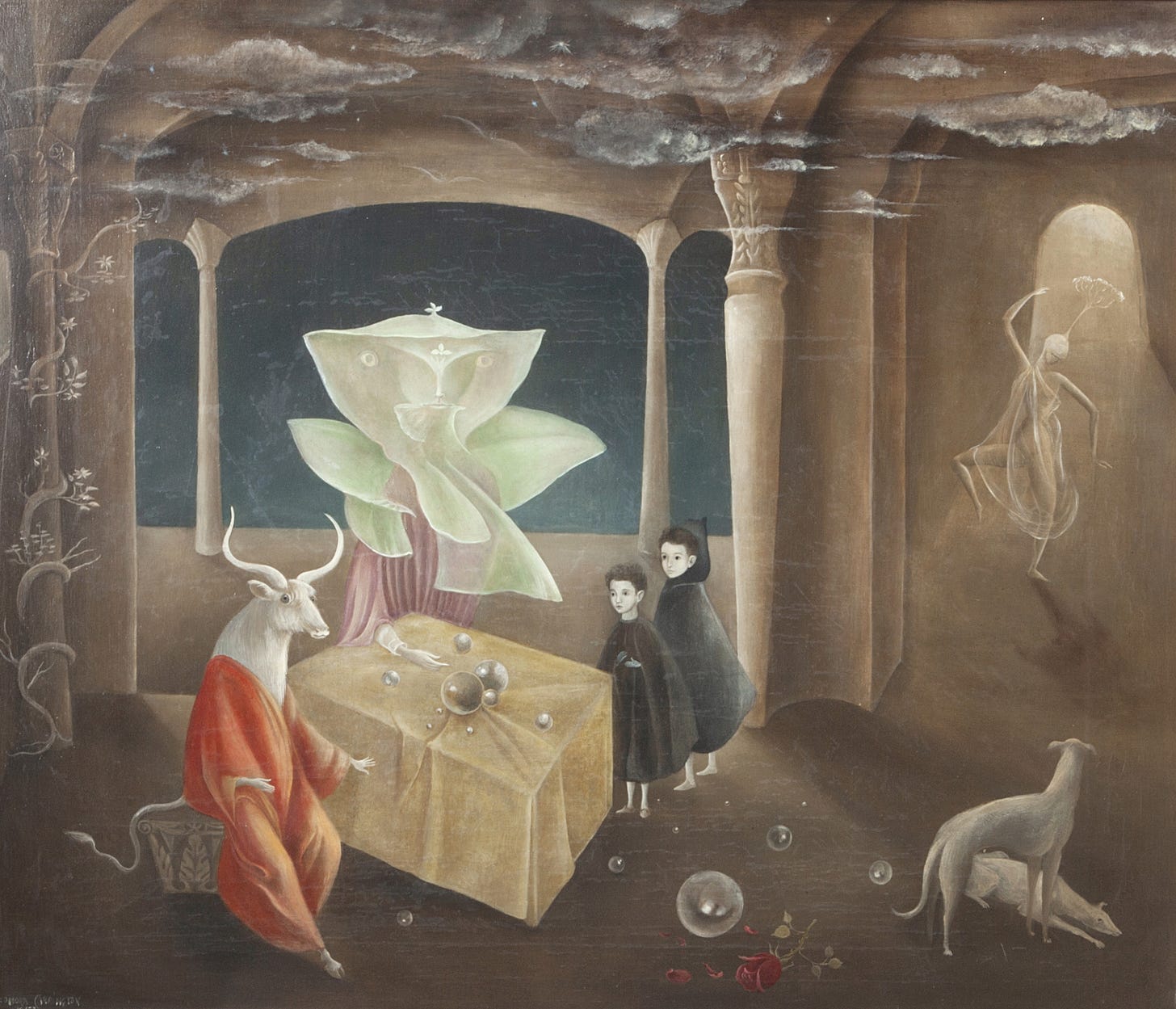The Minotaur on the Couch
More family drama courtesy of Greek mythology except this time there's bestiality and a sprinkling of ✨ psychoanalysis ✨
This week we are grabbing the bull by the horns 🐂 !!
By bull I am referring to everyone’s favourite half-man half-bovine hybrid, the Minotaur from Greek myth, and when I say grab by the horns I mean fling you towards the far more capable/qualified hands of this week’s guest writer, Natalie Lawrence. Before I hand you over may I firstly welcome all the newbies — it is such an honour to have you here and I truly hope you are enjoying the chaotic/unfiltered/NSFW snippets of Greek mythology, archaeology, and classics that I sneak into your inbox.
I’m currently working on a piece all about the Greeks’ most mysterious sex position (iykyk) which will be with you shortly and then my dear friend Ria is letting me publish the poem they wrote for an event of mine a few years ago that had the crowd in TEARS (it’s about Achilles and Patroclus so I would start hoarding kleenex now). For those of you not content with online dating, I am also hosting an in person event in London on the 15th of February. It’s going to be a four-course supper club which I make infinitely more complicated by cramming in as much Eros and Psyche inspired aspects as humanly possible (yay valentine’s day 🏹). Think theatre, edible flowers, art history, wax play, and whatever else I can squeeze in and slap a coat of mythological paint on. Info and tickets can be found here: Aphrodite’s Archer: an evening with Eros and Psyche.
With that teeny plug out of the way, over to you Natalie.
Everyone knows the Minotaur, the bull-headed beast that inhabited the Labyrinth of ancient Crete. Today, I want to delve into the lesser-known details of the Minotaur’s story with you. He might seem like a simple brute but I think he’s been deeply misunderstood. What lies under the gnarly exterior? This enigma has kept him alive in our imaginations for several thousand years, inspired countless remakes, retellings and re-hashings of his mythology.
But first, a brief recap of the situation at the Palace of Knossos in ancient Crete, for those who are rusty.
King Minos was a real hard-ass when it came to international relations. His favourite hobby was beating up nearby Mediterranean kingdoms with his armies, sucking up their wealth and power, until Crete dominated the entire region.
So, when Minos’s own son was killed in Athens, probably in a sporting accident, he could indulge in a revenge as vicious as he pleased. Minos forced the Athenians to send a tribute of young men and women to Crete every nine years, to feed to the beast that he kept locked up in an inescapable Labyrinth under his palace. This was the Minotaur, a monster with the gigantic body of a man, the head of a bull, and a taste for human flesh. At least, human flesh was the only thing the monster was ever fed - whether he liked it or not.
The captives arrived in Crete by ship and were led up to Knossos palace, scared and trembling. They were feasted and made much of for one night, before being tossed into the maze and left to their fate with the blood-thirsty beast. None ever made it back out again.
Eventually, Theseus, Prince of Athens, was old enough to understand that his city was being figuratively proverbialized by Minos. He decided to put a stop to the situation. Volunteering as one of the tributes, he entered the Labyrinth and slew the Minotaur (with no small help from Minos’s doe-eyed daughter, Ariadne). Then they all snuck away on a ship in the dead of night.
Of course, there’s no historical evidence for any of this – we know that Knossos Palace existed in ancient Crete and that they really liked bulls. That’s about it. But so many writers – both ancient and modern – have described Minos and his monster, that the myth has long been our dominant image of ‘Minoan’ Crete. It’s a culture that we know so little about: there’s even a whole written script that we have yet to decode (Linear B has been translated, Linear A is still impenetrable). Fantasies of Minoan Crete, though, have fired up artistic imaginations for millennia - in no small part because of this story of the bull-man in his Labyrinth.
It might be hard to imagine that an overly-vascularised muscle mountain filled with murderous rage might be an unfairly-maligned figure. Even, one worthy of greater understanding - but hear me out. The Minotaur didn’t necessarily intend to become a subterranean horror. He even had a name before he became The Minotaur, which was Asterion, meaning ‘the starry one’. Sadly ironic, given that he was locked away in the Labyrinth for most of his life. Once that door shut on the bull-boy, Asterion never saw the sky again. Not even once.
That shifts the tone a bit, doesn’t it?
Now that we’re properly acquainted, let’s try an experiment: to psychoanalyse Asterion as if he were a person. It’s not an exercise you can do with many classical monsters – the Lernaean Hydra or Typhon for example. There’s too little to go on. They simply aren’t characters: they’re relatively simple figures in a metaphorical landscape. While the Minotaur is also just a cardboard cut-out when he appears in Classical texts such as Ovid’s Metamorphoses or Seneca’s Phaedra, and even later ones such as Dante’s Inferno, there’s so much to be inferred from the space around him.
So many modern villains lean on mummy and daddy issues these days, but the Minotaur pre-empted this trend. Minos was actually Asterion’s stepfather, and quite a piece of work. Asterion’s mother was Minos’s wife, Pasiphaë, who wasn’t much better. If Asterion were to go to talk therapy, he would probably hunker down on the couch in obstinate silence. But we can read between the lines for him.
So, let’s begin. Exhibit 1: Mother.
Pasiphaë was the daughter of the Sun God Helios and the ocean nymph, Perse. This divine lineage was presumably how she survived being impregnated with her little monster son, when she got amorous with one beautiful White Bull.
A recent addition to Minos’s herds, Pasiphaë became infatuated with him. After weeks of mooning around after her burly and indifferent lover, the lust became too much for Pasiphaë. She persuaded the clever craftsman, Daedalus, to make her a lifelike model of a cow, upholstered with finest cowhide – for realism and, presumably, comfort. They carried it to the centre of the White Bull’s fields and Daedalus shut Pasiphaë inside. The cow model worked a treat, making the Bull unprecedentedly lusty for Pasiphaë, to her great delight.
The baby that resulted from this brief and bestial fling was Asterion. Being half human half bull, he was the very embodiment of Pasiphaë’s transgression. Having given in to her baser instincts and set her son up for - at the very least - a life of being thoroughly bullied (pun!), Pasiphaë then abandoned him to his fate, making no particular effort to prevent his incarceration in the Labyrinth. She did have a gaggle of other children to look after, though, so perhaps she wasn’t that fussed.
Exhibit 2: Father.
Now, contrary to the stereotype of everything being mother’s fault, in Asterion’s case, most blame probably lies at his stepfather’s feet (and the white Bull’s, of course, who was nothing if not an absent father). The Minotaur, meaning ‘Bull of Minos’ (Minos-taurus) – was even named after his stepfather (like those American kids called ‘Randy-Jr.’ and whatnot)
Pasiphaë’s infatuation for the White Bull was originally Minos’s fault. Poseidon had sent the animal to Minos as a sacrificial offering (like buying your own birthday presents). Minos got greedy, and tried to sacrifice an inferior bull so he could keep the monumental white one. As a punishment, Poseidon planted the idea in Pasiphaë’s head that the White Bull was the sexiest thing on four legs – maybe even two.
Much to Minos’ chagrin, he found himself with a bull that attracted all of his wife’s attention, as well as that of his prize heifers. That Minos spent most of his time terrorizing the Mediterranean and ignoring his home life can only have made the marital situation worse.
(It may also have been the White Bull that killed Minos’s son after it escaped to run wild across Greece, necessitating the tributes to feed the Minotaur, adding a strange circularity to the whole thing.)
Minos’s mother had also been through something similar (generational trauma, anyone?). She was Europa, a Phoenician princess who was abducted by Zeus in the form of a bull and carried across the sea to Crete. This might be why Minos was so especially sensitive about the appearance of his illegitimate stepson: his mother and now his wife had both been diddled by supernatural livestock.
Exhibit 3: Childhood
Now, I’m not saying it was all bad. There is a rather sweet picture of Pasiphaë dandling her minotaur baby on a piece of pottery from the 4th C BCE. Her expression suggests he wasn’t the baby of her dreams, but there’s the glimmerings of motherly instinct there.
It was pretty bad, though. Minos and Pasiphaë argued constantly, hurling the blame for the monstrous birth at one another (Euripides wrote a whole play about this called The Cretans, which exists in fragmentary form).
And of course, Asterion was soon a prisoner instead of a son. Whether it was because the bull-boy became bloodthirsty and dangerous, or because he wanted to forget the shame, Minos ordered Daedalus to build the Labyrinth. The maze was so clever and so inescapable that Daedalus nearly got lost in it himself during the construction process. Rather than trying to take ownership of his mistakes, Minos decided to sweep Asterion under the rug - about ten feet under - and lock him away where nobody would see him. And then use him as his personal human waste disposal unit.
So, from a young age, Asterion found himself incarcerated indefinitely, with nothing to do except hunt people once in a blue moon. He must have felt like a snake having a bunch of crickets periodically loosed into its tank. It’s no wonder that was homicidal by the time Theseus got to him, about 2 decades later. Most of us would probably feel like gnawing on someone by that point.
My point is: Asterion might have looked a fright, but it wasn’t all his fault that he was a monster. He was made monstrous.
I’m going to get serious now, just to warn you.
There’s something in this story for all of us. We can explain away the myth with geographical links, possible historical people and events, religious symbolism or however else it might have originated - the details of which I won’t go through here. But this monster doesn’t need explaining. He doesn’t say much but he still speaks to us.
To get all Freudian about it: perhaps we all of us have a Labyrinth inside us, trapping and masking our monstrous parts. And the more we keep them hidden away, the more horrible we feel they, and by extension - we, are. The more terrible the tax they exact on our lives and relationships.
It’s a scary and risky thing to do, going to meet your inner monsters. We risk losing control of them, and even worse, the judgement of others. Minos certainly couldn’t hack it. He tried to pretend that his kingdom was all in order and paid a terrible price for keeping the beast alive privately.
This is where the power of the Minotaur’s story lies: this insight carried through the centuries what happens to the monsters that inhabit us if we try to lock away with mazes of defences. They grow more terrible by repression. The beasts that are in us all need breathing room and, most of all, understanding.
Of all the modern renditions of the Minotaur – from Picasso to Byrne Jones - a painting by the surrealist Leonora Carrington is my favourite. It’s called ‘And then we saw the daughter of the Minotaur’ (1953, currently at MoMA, NY). Two children, based on Leonora’s own, stand before a table at which sits a perfectly white Minotaur, dressed in an elegant red robe.
She’s not a monster: she leans forward, delicate hands open, as if inviting them to speak. Her hybrid form carries the trauma of the generations before. But in the dreamscape of the painting, it is not terrible - or threatening. It’s simply one of the strange elements from the deep recesses of Carrington’s mind. Her inner monsters were allowed out to play on the regular – so her minotaur was a gentle one.
So that is my reading, for your consideration. If you agree - great, if you vehemently disagree - even better. That’s what monsters are for. And maybe I’ll tell you about the obscure Moon Goddess ritual hypotheses and fruity execution methods another time.
References:
If you’d like to delve deeper into the Classical references to the Minotaur, check out theoi.org’s page here
Then if you’d like to read more about my thoughts on the Minotaur and other monsters, check out my new book, Enchanted Creatures: Our Monsters and Their Meanings (W&N, 2024)
For a tongue-in-cheek retelling with no analytical frills, check out my article in Berfrois (2019)
Natalie Lawrence has a Masters and PhD in History and Philosophy of Science from the University of Cambridge. She has written for New Scientist, Aeon Magazine, Atlas Obscura and BBC Wildlife, amongst others, and spoken for TEDX, BBC Radio and podcasts. Her latest book is Enchanted Creatures: Our Monsters and Their Meanings (W&N, 2024; Pegasus 2025), a history of monsters and the imagination. She lives in a converted church in London - filled with creatures and specimens - working as a writer, teacher, speaker and illustrator.








Very interesting, and a great way of understanding the myth. My Centaur self enjoyed it.
Thank you for the deep dive down into the labyrinth — and the fate of the bull boy. To hear all sides of the character’s past story sheds a tiny ray of light in understanding the buried monster. Great read!